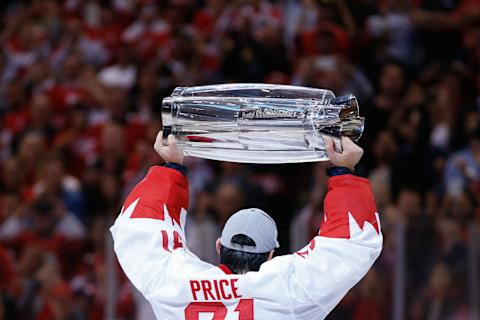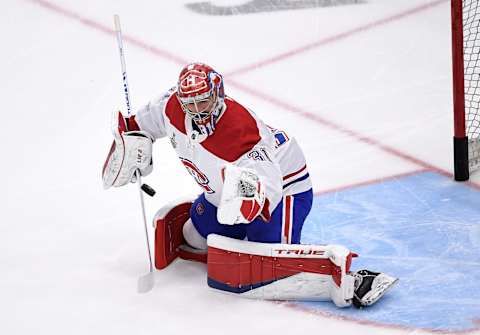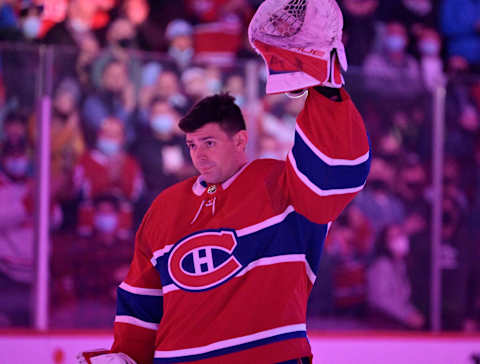Montreal Canadiens: Breaking Down Carey Price vs Jaroslav Halak – The Verdict Is Finally In

With Montreal Canadiens goaltender Carey Price on long term injured reserve and former Habs netminder Jaroslav Halak still without a contract for this season, the careers of the once star crossed goaltenders of the Canadiens appear to be all but over.
Halak was just brought in for a professional try out by the Carolina Hurricanes last week and could resurface in the NHL again at some point, but it will likely be as nothing more than a backup and spot starter.
So now seems as good a time as ever to re-litigate one of the great debates in recent Habs history, Price or Halak. In 2010, the two young netminders were at the center of a firestorm over which one of them the Canadiens should move forward with as the club’s franchise goaltender. Everybody had an opinion but now 13 years later perhaps we can settle the argument once and for all.
They say numbers never lie, but in this case I think perhaps they do. Price and Halak have near identical stats for career goals against average and career save percentage. Price is at 2.51 and .917 while Halak is at 2.50 and .915. Their career shutout totals are also pretty close with Halak holding a slight edge 53-49.
Price has much more gaudy totals in career games played with 712 to Halak’s 581. Consequently, career wins also heavily favor Price 361-295. Their regular season win percentage though is surprisingly the exact same at 50.7%.
Their playoff resumes further their statistical equivalence to a degree. Price has a record of 43-45 with a 2.39 GAA and .919 save percentage in 89 career playoff starts. In a smaller sample size, Halak had eerily similar results posting a 17-20 record with a 2.48 GAA and .919 save percentage in 37 career starts in the postseason. It should be noted though that Price also has 8 playoff shutouts to his name while Halak has none.
As we know statistics alone don’t tell the whole story. Judging a goaltender’s worth requires much more context.

The Raw Numbers
Price was a true workhorse for the Canadiens. He appeared in 50 or more games in a season eight times and his team made 10 playoff appearances in his 14 seasons between the pipes.
The Anahim Lake, B.C. native spent his entire NHL career with the team that drafted him fifth overall in 2005, leading them to the Eastern Conference Final in 2014 and the Stanley Cup Final in 2021. Among his many individual accolades he won the Hart Trophy as the NHL’s most valuable player and Vezina Trophy as the league’s most outstanding goaltender in 2015.
In contrast, Halak had only three seasons of 50+ starts, usually profiling more as one half of a tandem. Following his magical run to the Conference Final with the Habs in 2010, his teams made the postseason only three times for the duration of his career. Most of Halak’s excellent playoff numbers were built off that incredible spring with the CH. The fact is he won only one playoff series after departing Montreal.
Halak, a ninth round pick in 2003, became a bit of a journeyman. A quality journeyman at that but he would end up tending goal for seven different teams (so far) before it was all said and done. He was a quality starter for a number of years but always a tier below the Price-led superstar club.
In addition to his time with the Canadiens, Halak suited up for the Blues, Capitals, Islanders, Bruins, Canucks and Rangers. It was with Boston that Halak won his only other playoff series, winning two of three games after he took over for starter Tuukka Rask when the latter departed the covid bubble prior to Game 3 of a tied best of five first round series.
The only time Price and Halak actually squared against each other in a meaningful way was in the World Cup of Hockey in 2016. Halak, a native of Slovakia, had backstopped the underdog Team Europe to the final where they eventually ran into and fell to the superior Team Canada, led by Price.
Price enjoyed tremendous success on the international stage throughout his career. In addition to the World Cup win, he captured gold with Canada at both the World Juniors and the Olympics. His reputation as a big game goaltender cemented his legacy as the best of his generation.
So while their overlying numbers are similar, Price clearly had the more decorated career. But that was never the question was it. The question was, is and always will be would the Canadiens have been better off as a team with Halak instead of Price?

What If Price Was Traded?
Now we are dealing in the world of hypotheticals and it’s a two part what if question really. Firstly, what could the Canadiens have gotten in a trade for Price had they elected to keep Halak instead? Surely more than Lars Eller and Ian Schultz but how impactful could the trade have been.
The truth is, it’s impossible to quantify what a trade for Price would have even looked like. While he had the pedigree, Price was from a sure thing at the time. He had struggled with consistency and had not yet proven that he could be relied upon to carry the load. So while it’s easy to suggest that Price would have fetched a haul of picks and prospects or could have been flipped for a true impact player, the truth is the Habs were likely going to receive far less.
It’s been rumoured that Canadiens general manager Bob Gainey had offered Price in a package with some combination of fellow young stars including Max Pacioretty and P.K. Subban in an effort to pry Vincent Lecavalier out of Tampa in 2009.
If true it seems plausible that Gainey disciple Pierre Gauthier could have attempted a similar deal in 2010. Would the Habs really have been better off with Halak and Lecavalier, or another player of his ilk, instead of Price, Subban and Pacioretty?
Hard to say but that leads us to the second and more intriguing question. Would the Canadiens have fared better by having a cheaper goaltending option than Price and his 10.5 million dollar hit? In theory, this would have altered the club’s roster construction and freed up money previously allotted to their goaltending to be spent instead in other areas.

Salary Cap Reality and Final Verdict
Let’s test that theory out. Both players were restricted free agents going into the 2010 offseason. After his trade to St. Louis, Halak immediately signed a four year, $15 million contract with the Blues for an AAV of $3.75 million. Price on the other hand inked a new two year bridge deal with the Canadiens for 5.5 million, so a cap hit of $2.75 million. I would say the salary difference there is negligible.
Price signed a six year, $39 million extension with Montreal in 2012, which works out to an annual cap hit of $6.5 million. So for the two years between 2012 and 2014, Price was making $2.75 million more than Halak. This time period includes the season in which the Habs reached the Conference Final and ultimately lost to the New York Rangers after Price was injured in the series opener. Theoretically, the Canadiens would have had Halak and the cap space for an additional $3 million dollar player. Would that have been enough to push them over the top?
Halak found a new home when he became an unrestricted free agent in 2014 and signed a four year, $18 million dollar with the New York Islanders. That translates to a cap hit of $4.5 million. So from 2014 to 2017, the peak Price years, the salary cost difference between the two was just 2 million dollars, so not much difference at all.
The big dollar shift occurs with Price’s next contract, a monster eight year deal for $84 million that kicked in at the start 2018-19. The average annual salary of $10.5 million is the highest in NHL history among goaltenders.
Simultaneously, Halak joined his third team by inking a two year, $5.5 million dollar deal with the Boston Bruins. No longer a true number 1 after playing the 1B behind Thomas Greiss on Long Island for years, Halak accepted a similar role to back up Rask at a cap hit of just $2.75 million. For context, Rask as the starter was making $7 million.
The fact is Price only lasted three years into his massive extension before injuries derailed his career, so the argument that his $10.5 million dollar cap hit was the reason the Canadiens could not build a true Cup contender doesn’t hold water. They made it to the finals in his last full season and would certainly not have done so without Price’s heroics.
The conclusion to this age old debate is that dealing Price and hitching your wagon to Halak would have been a roll of the dice that in hindsight was a risk not worth taking. Building your team around the league’s highest paid goaltender could have worked had the Canadiens management been able to put a better team in front of him.
The final verdict is in. Price was the right choice, he was everything the Habs could have hoped for and more. A generational talent that deserved better, it was the Canadiens that failed him not the other way around.
Next. Bold Trades To Take Advantage of Struggling Contenders. dark

Want your voice heard? Join the A Winning Habit team!